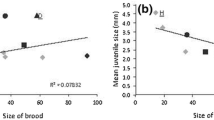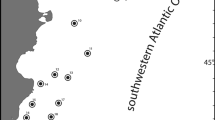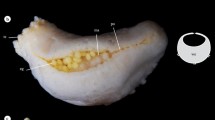Abstract
Brooding, embryonic and larval development, and the influence of environmental and biological factors in tidepool habitats were studied in the sea star, Anasterias minuta, at various sites along ~220 km of the Patagonian coast. This species has a benthic, lecithotrophic development that includes eight distinct developmental stages. A larval organ, the connection cord, is developed from a small preoral lobe at early stages of development and becomes larger and thinner at advanced stages. Fecundity and average egg size increased with female body size. The regression of log egg number to log sea-star size and weight at different sites had a slope significantly less than 3.0, resulting in negative allometry and indicating that brood capacity was limited in large females. Development was generally synchronous among sites, but varied within each brood at advanced stages, with more developed brooded larvae located at the periphery of the brood mass. Brooding was synchronous among various populations at different years and spatial scales, and extended over a period of 8 months. The highest proportion of brooding females occurred during May and June (austral winter). Juveniles were released mainly during September. The likelihood of finding brooding sea stars decreased with increasing sea water temperature, tidal height, and wave exposure, and increased with increasing body size. Both body size of brooding females and brooding rate were higher in the infralittoral fringe than at midlittoral levels. A revision of the current model of brooding behavior and development among forcipulate sea stars is given.







Similar content being viewed by others
References
Agresti A (2007) An introduction to categorical data analysis, 2nd edn. Wiley, New York
Aiken LS, West SG (1991) Multiple regression: testing and interpreting interactions. Newbury Park, Sage
Arnaud PM (1974) Contribution à la bionomie marine benthique des regions antarctiques et subantarctiques. Tethys 6:465–556
Baker P, Mann R (1997) The postlarval phase of bivalve mollusks: a review of functional ecology and new records of postlarval drifting of Chesapeake Bay bivalves. Bull Mar Sci 61:409–430
Bernasconi I (1964) Distribución geográfica de los Equinoideos y Asteroideos de la extremidad austral de Sudamérica. Boletín del Instituto de Biología Marina (Mar del Plata) 7:43–50
Bertness MD, Gaines SD, Stephens EG, Yund PO (1992) Components of recruitment in populations of the acorn barnacle Semibalanus balanoides (Linnaeus). J Exp Mar Biol Ecol 156:199–215
Bertness MD, Crain CM, Silliman BR, Bazterrica MC, Reyna V, Hildago F, Farina JK (2006) The community structure of western Atlantic Patagonian rocky shores. Ecol Monogr 76:439–460
Bingham BL, Giles K, Jaeckle W (2004) Variability of broods of the seastar Leptasterias aequalis. Can J Zool 82:457–463. doi:10.1139/Z04-009
Blankley WO, Branch GM (1984) Co-operative prey capture and unusual brooding habits of Anasterias rupicola (Verrill) (Asteroidea) at sub-Antarctic Marion Island. Mar Ecol Prog Ser 20:171–176
Boivin YY, Larrivée D, Himmelman JH (1986) Reproductive cycle of the subarctic brooding asteroid Leptasterias polaris. Mar Biol 92:329–337. doi:10.1007/BF00392673
Bosch I, Pearse JS (1990) Developmental types of shallow-water asteroids of McMurdo Sound, Antarctica. Mar Biol 104:41–46. doi:10.1007/BF01313155
Bosch I, Slattery M (1999) Costs of extended brood protection in the Antarctic sea star, Neosmilaster georgianus (Echinodermata: Asteroidea). Mar Biol 134:449–459. doi:10.1007/s002270050561
Byrne M (1992) Reproduction of sympatric populations of Patiriella gunnii, P. calcar and P. exigua in New South Wales, asterinid seastars with direct development. Mar Biol 114:297–316. doi:10.1007/BF00349533
Byrne M (1995) Changes in larval morphology in the evolution of benthic development by Patiriella exigua (Asteroidea: Asterinidae), a comparison with the larvae of Patiriella species with planktonic development. Biol Bull 188:293–305
Byrne M (1996) Viviparity and intragonadal cannibalism in the diminuitive sea stars Patiriella vivipara and P. parvivipara (Family Asterinidae). Mar Biol 125:551–567. doi:10.1007/BF00353268
Byrne M (2005) Viviparity in the sea star Cryptasterina hystera (Asterinidae)—conserved and modified features in reproduction and development. Biol Bull 208:81–91. doi:10.2307/3593116
Chen BY, Chen CP (1992) Reproductive cycle, larval development, juvenile growth and population dynamics of biology of Patiriella pseudoexigua (Echinodermata: Asteroidea) in Taiwan. Mar Biol 113:271–280
Chia FS (1966) Brooding behavior of a six rayed starfish, Leptasterias hexactis. Biol Bull 130:304–315
Chia FS (1968) The embryology of a brooding starfish, Leptasterias hexactis. Acta Zool Stockh 49:321–364
Chia FS, Walker CW (1991) Echinodermata: Asteroidea. In: Giese A, Pearse J, Pearse V (eds) Reproduction of marine invertebrates, vol VI. Boxwood Press, California, pp 301–353
Clark HES (1962) The fauna of the Ross Sea. Part 3, Asteroidea. Bull NZ Dep Scient Ind Res 151:1–84
Clark A, Downey M (1992) Starfish of the Atlantic. An illustrated key. Koeltz Scientific Book, Cambridge
Clarke A, Crame JA (2010) Evolutionary dynamics at high latitudes: Speciation and extinction in polar marine faunas. Phil Trans R Soc B 365:3655–3666. doi:10.1098/rstb.2010.0270
Cohen C, Strathmann R (1996) Embryos at the edge of tolerance: effects of environment and structure of egg masses on supply of oxygen to embryos. Biol Bull 190:8–15
Eernisse DJ, Strathmann MF, Strathmann RR (2010) Henricia pumila sp. nov.: A brooding seastar (Asteroidea) from the coastal northeastern Pacific. Zootaxa 2329:22–36
Everingham JW (1961) The intra-ovarian embryology of Leptosynapta clarki. MS Thesis, University of Washington, Seattle, USA
Fernández M, Ruiz-Tagle N, Cifuentes S, Pörtner HO, Arntz W (2003) Oxygen-dependent asynchrony of embryonic development in embryo masses of brachyuran crabs. Mar Biol 42:559–565. doi:10.1007/s00227-002-0965-8
Fisher WK (1930) Asteroidea of the North Pacific and Adjacent Waters, Pt. 3: Forcipulata. Bull US Nat Mus 76:1–356
Fisher WK (1940) Asteroidea. Discov Rep 20:1–305
George SB (1994a) Population differences in maternal size and offspring quality for Leptasterias epichlora (Brandt) (Echinodermata: Asteroidea). J Exp Mar Biol Ecol 175:121–131. doi:10.1016/0022-0981(94)90179-1
George SB (1994b) The Leptasterias (Echinodermata: Asteroidea) species complex: variation in reproductive investment. Mar Ecol Prog Ser 109:95–98
Gil DG, Zaixso HE (2007) The relation between feeding and reproduction in Anasterias minuta (Asteroidea: Forcipulata). Mar Biol Res 3:256–264. doi:10.1080/17451000701472035
Gil DG, Zaixso HE (2008) Feeding ecology of the sub-Antarctic sea star Anasterias minuta within tide pools in Patagonia, Argentina. Rev Biol Trop 56:311–328
Gil DG, Zaixso HE, Tolosano JA (2009) Brooding of the sub-Antarctic heart urchin, Abatus cavernosus (Spatangoida: Schizasteridae), in southern Patagonia. Mar Biol 156:1647–1657. doi:10.1007/s00227-009-1200-7
Gould SJ (1966) Allometry and size in ontogeny and phylogeny. Biol Rev Camb Philos Soc 41:587–640
Haesaerts D, Jangoux M, Flammang P (2006) Adaptations to benthic development: functional morphology of the attachment complex of the brachiolaria larva in the sea star Asterina gibbosa. Biol Bull 211:172–182. doi:10.2307/4134591
Hamel JF, Mercier A (1995) Prespawning behavior, spawning, and development of the brooding starfish Leptasterias polaris. Biol Bull 188:32–45
Hayashi R (1943) Contributions to the classification of the sea-stars of Japan. II. Forcipulata, with the note on the relationships between the skeletal structure and respiratory organs of the sea-stars. J Fac Sci Hokkaido Univ Ser 6 Zool 8:13–281
Hendler G (1979) Sex-reversal and viviparity in Ophiolepis kieri, n. sp., with notes on viviparous brittlestars from the Caribbean (Echinodermata: Ophiuroidea). Proc Biol Soc Wash 92:783–795
Hendler G, Franz DR (1982) The biology of a brooding seastar, Leptasterias tenera, in Block Island sound. Biol Bull 162:273–289
Hernández DA, Tablado A (1985) Asteroidea de Puerto Deseado (Santa Cruz, Argentina). Contribución No104. CENPAT, Argentina
Himmelman JH, Lavergne Y, Cardinal A, Martel G, Jalbert P (1982) Brooding behaviour of the Northern sea star Leptasterias polaris. Mar Biol 68:235–240. doi:10.1007/BF00409590
Hines AH (1982) Allometric constraints and variables of reproductive effort in brachyuran crabs. Mar Biol 69:309–320. doi:10.1007/BF00397496
Hosmer DW, Lemeshow S (2000) Applied logistic regression, 2nd edn. Wiley, New York
Hyman LH (1955) Echinodemata. The Invertebrates. IV. McGraw-Hill, New York
Kamel SJ, Grosberg RK, Marshall DJ (2010) Family conflicts in the sea. Trends Ecol Evol 5:442–449. doi:10.1016/j.tree.2010.05.008
Koehler R (1906) Echinodermes. Exped Ant Française (1903–1905), 41 p
Komatsu M, Kano YT, Yoshizawa H, Akabane S, Oguro C (1979) Reproduction and development of the hermaphroditic sea-star, Asterina minor Hayashi. Biol Bull 157:258–274
Komatsu M, O’Loughlin PM, Bruce B, Yoshizawa H, Tanaka K, Murakami C (2006) A gastric-brooding asteroid, Smilasterias multipara. Zool Sci 23:699–705
Lane DJW, Beaumont AR, Hunter JR (1985) Byssus drifting and the drifting threads of the young post-larval mussel Mytilus edulis. Mar Biol 84:301–308. doi:10.1007/BF00392500
Lawrence JM, Herrera J (2000) Stress and deviant reproduction in echinoderms. Zool Stud 39:151–171
Lawrence JM, McClintock JB, Guille A (1984) Organic level and caloric caloric content of eggs of brooding asteroids and an echinoid (Echinodermata) from Kerguelen (South Indian Ocean). Int J Invert Reprod Dev 7:249–257
Lieberkind I (1920) On a starfish (Asterias groenlandica) which hatches its young in its stomach. Vidensk Medd Dan Naturhist Foren 72:121–126
Lindegarth M, Gamfeldt L (2005) Comparing categorical and continuous ecological analyses: effects of “wave exposure” on rocky shores. Ecology 86:1346–1357
Litulo C (2005) Fecundity and size at sexual maturity of the fiddler crab Uca vocans (Linnaeus, 1758) (Brachyura: Ocypodidae). Thalassas 21:59–65
Ludwig H (1903) Seesterne. Résultats du voyage du S.Y. Belgica en 1897-1898-1899. Rapp Sci, Zool R20:1–72
Macbride EW, Simpson JC (1908) Echinoderma II. Echinoderm larvae. Nat Ant Exp (1901–1904) 4 (Zool):1–9
McClary DJ, Mladenov PV (1990) Brooding biology of the sea star Pteraster militaris (O.F. Müller): energetic and histological evidence for nutrient translocation to brooded juveniles. J Exp Mar Biol Ecol 142:183–199. doi:10.1016/0022-0981(90)90090-Y
McClintock JB, Pearse JS (1986) Organic and energetic content of eggs and juveniles of antarctic echinoids and asterids with lecithotrophic development. Comp Bioch Physiol A 85:341–345
McEdward LR, Janies DA (1993) Life cycle evolution in asteroids: What is a larva? Biol Bull 184:255–268
McEdward LR, Janies DA (1997) Relationships among development, ecology, morphology in the evolution of echinoderm larvae and life cycles. Biol J Linn Soc 60:381–400
McEdward LR, Miner BG (2001) Larval and life-cycle patterns in echinoderms. Can J Zool 79:1125–1170. doi:10.1139/cjz-79-7-1125
Menge BA (1974) Effect of wave action and competition on brooding and reproductive effort in the seastar, Leptasterias hexactis. Ecology 55:84–93
Menge BA (1976) Organization of the New England rocky intertidal community: role of predation, competition, and environmental heterogeneity. Ecol Monogr 46:355–393
Mercier A, Hamel JF (2008) Depth-related shift in life history strategies of a brooding and broadcasting deep-sea asteroid. Mar Biol 156:205–223. doi:10.1007/s00227-008-1077-x
Metaxas A, Scheibling RE (1993) Community structure and organization of tidepools. Mar Ecol Prog Ser 98:187–198
Meyer E, Manahan DT (2009) Nutrient uptake by marine invertebrates: cloning and functional analysis of amino acid transporter genes in developing sea urchins (Strongylocentrotus purpuratus). Biol Bull 217:6–24
Mortensen T (1920) Studies in the development of crinoids. Pap Department of Marine Biology, Carnegie Institution of Washington, vol 16, pp 1–94
Naughton KM, O’Hara TD (2009) A new brooding species of the biscuit star Tosia (Echinodermata: Asteroidea: Goniasteridae), distinguished by molecular, morphological and larval characters. Invertebr Syst 23:348–366
Niesen TM (1973) Population and reproductive biology of the six-rayed sea star Leptasterias hexactis on the protected outer coast. PhD Thesis, University of Oregon, USA
O’Brien FX (1976) Some adaptations of the seastar, Leptasterias littoralis (Stimpson) to life in the intertidal zone. Thalassia Jugoslavica 12:237–243
O′Loughlin PM, O′Hara DT (1990) A review of the genus Smilasterias (Echinodermata, Asteroidea) with descriptions of two new species from south-eastern Australia, one a gastric brooder, and a new species from Maqcuarie Island. Mem mus Victoria 50:307–329
Osterud HL (1918) Preliminary observations on the development of Leptasterias hexactis. Publ Puget Sound St 2:1–15
Pearse JS, Bosch I (1994) Brooding in the Antarctic: Östergren had it nearly right. In: David B, Guille A, Féral JP, Roux M (eds) Echinoderms through time. Balkema, Rotterdam, pp 111–120
Pearse JS, Mooi R, Lockhart SJ, Brandt A (2009) Brooding and species diversity in the Southern Ocean: selection for brooders or speciation within brooding clades? In: Krupnik I, Lang MA, Miller SE (eds) Smithsonian at the poles: contributions to international polar year science. Smithsonian Institution, Washington, pp 181–196
Perrier E (1891) Echinodermes de la mission scientifique du Cap Horn. Stellérides. Miss Sci Cap Horn Zool 6:1–168
Philippi RA (1870) Neue Seesterne aus Chile. Arch Naturges 36:268–275
Prowse TAA, Pile AJ (2005) Phenotypic homogeneity of two intertidal snails across a wave exposure gradient in South Australia. Mar Biol Res 1:176–185
Prowse TAA, Sewell MA, Byrne M (2008) Fuels for development: evolution of maternal provisioning in asterinid sea stars. Mar Biol 153:337–349. doi:10.1007/s00227-007-0809-7
Raff RA, Byrne M (2006) The active evolutionary lives of echinoderm larvae. Heredity 97:244–252
Raymond JF, Himmelman JH, Guderley HE (2004) Sex differences in biochemical composition, energy content and allocation to reproductive effort in the brooding sea star Leptasterias polaris. Mar Ecol Prog Ser 283:179–190
Salvat MB (1985) Biología de la reproducción de Anasterias minuta Perrier (Echinodermata, Asteroidea), especie incubadora de las costas patagonicas. PhD thesis. Universidad de Buenos Aires, Argentina
Sewell MA (1996) Mortality of pentactulae during intraovarian brooding in the apodid sea cucumber Leptosynapta clarki. Biol Bull 190:188–194
Simpson RD (1982) The reproduction of some echinoderms from Macquarie Island. Austr Mus Mem 16:39–52
Smith EA (1876) Descriptions of species of Asteriidae and Ophiuridae from Kerguelen′s Island. Ann and Mag Nat Hist ser 4(17):105–113
Sokal RR, Rohlf FJ (1995) Biometry. The principles and practice of statistics in biological research, 3rd edn. WH Freeman and Company, New York
Soliman ES, Nojima S (1984) Some observations on dispersal behavior of the early juvenile of the sea-star, Asterina minor. Publ Anakrrsa Mar Biol Lab 7:81–93
Strathmann RR (1975) Larval feeding in echinoderms. Am Zool 15:717–730
Strathmann RR, Strathmann MF (1982) The relationship between adult size and brooding in marine invertebrates. Am Nat 119:91–101
Strathmann RR, Strathmann MF (1995) Oxygen supply and limits on aggregation of embryos. J Mar Biol Assoc UK 75:413–428. doi:10.1017/S0025315400018270
Strathmann RR, Strathmann MF, Emson RH (1984) Does limited brood capacity link adult size, brooding and simultaneous hermaphroditism? A test with the starfish Asterina phylactica. Am Nat 123:796–818
Turner RL, Dearborn JH (1979) Organic and inorganic composition of post-metamorphic growth stages of Ophionotus hexactis (E.A. Smith) (Echinodermata: Ophiuroidea) during intraovarian incubation. J Exp Mar Biol Ecol 36:41–51
Turner RL, Lawrence JM (1979) Volume and composition of echinoderm eggs: implications for use of egg size in life-history models. In: Stancky SE (ed) Reproductive ecology of marine invertebrates. Univ South Carolina Press, Columbia, pp 25–40
Vadas RL, Wright WA, Mille SL (1990) Recruitment of Ascophyllum nodosum: wave action as a source of mortality. Mar Ecol Prog Ser 61:263–272
Vance RR (1973) On reproductive strategies in marine benthic invertebrates. Am Nat 107:339–352
Verrill AE (1914) Monograph of the shallow-water starfishes of the North Pacific coast from the Arctic Ocean to California. Harriman Alaska Ser US Nat Mus 14:1–408
Villinski JT, Villinski JC, Byrne M, Raff RA (2002) Convergent maternal provisioning and life-history evolution in echinoderms. Evolution 56:1764–1775. doi:10.1111/j.0014-3820.2002.tb00190.x
Worley EK, Franz DR, Hendler G (1977) Seasonal patterns of gametogenesis in a North Atlantic brooding asteroid, Leptasterias tenera. Biol Bull 153:237–253
Zaixso HE (1975) Distribución vertical de los moluscos marinos de la ria Deseado (Santa Cruz, Argentina): sustratos con fracción limosa. Physis 34:229–243
Zaixso HE, Pastor CT (1977) Observaciones sobre la ecología de los mitílidos de la ría Deseado. I. Distribución y análisis biocenótico. Ecosur 4:1–46
Acknowledgments
The authors would like to thank Silvina Rosales and Maria Belén Reartes for their support during field surveys and Bárbara Kotoucek (UNPSJB) for assistance with German translation. This manuscript was further improved by comments of Howard Feder and two anonymous reviewers.
Author information
Authors and Affiliations
Corresponding author
Additional information
Communicated by M. Byrne.
Electronic supplementary material
Below is the link to the electronic supplementary material.
Rights and permissions
About this article
Cite this article
Gil, D.G., Escudero, G. & Zaixso, H.E. Brooding and development of Anasterias minuta (Asteroidea: Forcipulata) in Patagonia, Argentina. Mar Biol 158, 2589–2602 (2011). https://doi.org/10.1007/s00227-011-1760-1
Received:
Accepted:
Published:
Issue Date:
DOI: https://doi.org/10.1007/s00227-011-1760-1




